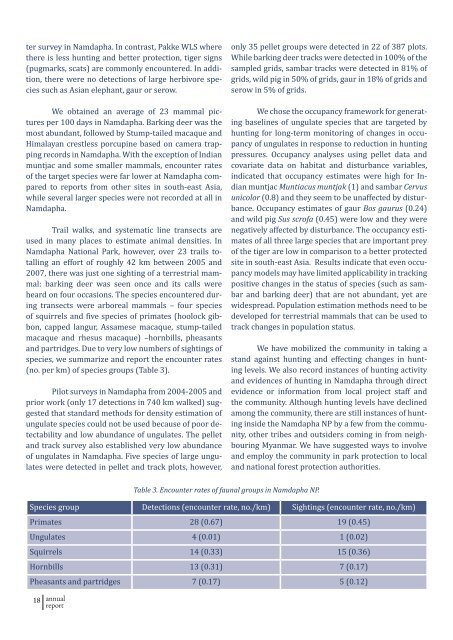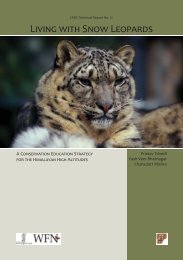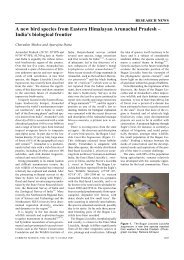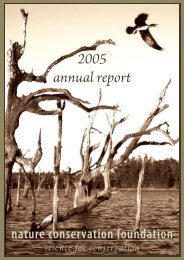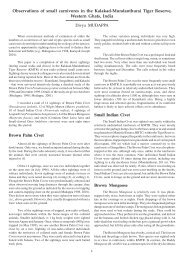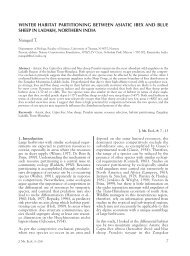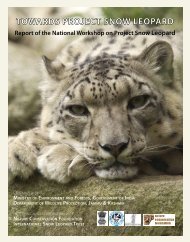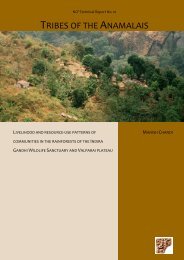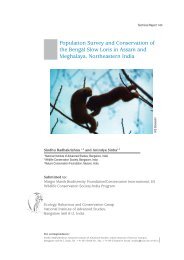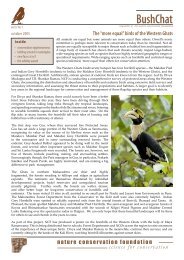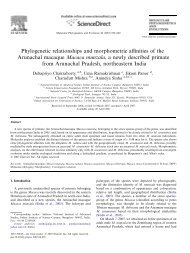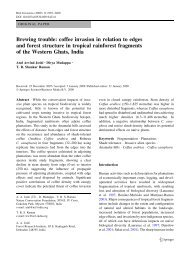2006-7 annual report - Nature Conservation Foundation
2006-7 annual report - Nature Conservation Foundation
2006-7 annual report - Nature Conservation Foundation
Create successful ePaper yourself
Turn your PDF publications into a flip-book with our unique Google optimized e-Paper software.
ter survey in Namdapha. In contrast, Pakke WLS where<br />
there is less hunting and better protection, tiger signs<br />
(pugmarks, scats) are commonly encountered. In addition,<br />
there were no detections of large herbivore species<br />
such as Asian elephant, gaur or serow.<br />
We obtained an average of 23 mammal pictures<br />
per 100 days in Namdapha. Barking deer was the<br />
most abundant, followed by Stump-tailed macaque and<br />
Himalayan crestless porcupine based on camera trapping<br />
records in Namdapha. With the exception of Indian<br />
muntjac and some smaller mammals, encounter rates<br />
of the target species were far lower at Namdapha compared<br />
to <strong>report</strong>s from other sites in south-east Asia,<br />
while several larger species were not recorded at all in<br />
Namdapha.<br />
Trail walks, and systematic line transects are<br />
used in many places to estimate animal densities. In<br />
Namdapha National Park, however, over 23 trails totalling<br />
an effort of roughly 42 km between 2005 and<br />
2007, there was just one sighting of a terrestrial mammal:<br />
barking deer was seen once and its calls were<br />
heard on four occasions. The species encountered during<br />
transects were arboreal mammals – four species<br />
of squirrels and five species of primates (hoolock gibbon,<br />
capped langur, Assamese macaque, stump-tailed<br />
macaque and rhesus macaque) –hornbills, pheasants<br />
and partridges. Due to very low numbers of sightings of<br />
species, we summarize and <strong>report</strong> the encounter rates<br />
(no. per km) of species groups (Table 3).<br />
Pilot surveys in Namdapha from 2004-2005 and<br />
prior work (only 17 detections in 740 km walked) suggested<br />
that standard methods for density estimation of<br />
ungulate species could not be used because of poor detectability<br />
and low abundance of ungulates. The pellet<br />
and track survey also established very low abundance<br />
of ungulates in Namdapha. Five species of large ungulates<br />
were detected in pellet and track plots, however,<br />
only 35 pellet groups were detected in 22 of 387 plots.<br />
While barking deer tracks were detected in 100% of the<br />
sampled grids, sambar tracks were detected in 81% of<br />
grids, wild pig in 50% of grids, gaur in 18% of grids and<br />
serow in 5% of grids.<br />
We chose the occupancy framework for generating<br />
baselines of ungulate species that are targeted by<br />
hunting for long-term monitoring of changes in occupancy<br />
of ungulates in response to reduction in hunting<br />
pressures. Occupancy analyses using pellet data and<br />
covariate data on habitat and disturbance variables,<br />
indicated that occupancy estimates were high for Indian<br />
muntjac Muntiacus muntjak (1) and sambar Cervus<br />
unicolor (0.8) and they seem to be unaffected by disturbance.<br />
Occupancy estimates of gaur Bos gaurus (0.24)<br />
and wild pig Sus scrofa (0.45) were low and they were<br />
negatively affected by disturbance. The occupancy estimates<br />
of all three large species that are important prey<br />
of the tiger are low in comparison to a better protected<br />
site in south-east Asia. Results indicate that even occupancy<br />
models may have limited applicability in tracking<br />
positive changes in the status of species (such as sambar<br />
and barking deer) that are not abundant, yet are<br />
widespread. Population estimation methods need to be<br />
developed for terrestrial mammals that can be used to<br />
track changes in population status.<br />
We have mobilized the community in taking a<br />
stand against hunting and effecting changes in hunting<br />
levels. We also record instances of hunting activity<br />
and evidences of hunting in Namdapha through direct<br />
evidence or information from local project staff and<br />
the community. Although hunting levels have declined<br />
among the community, there are still instances of hunting<br />
inside the Namdapha NP by a few from the community,<br />
other tribes and outsiders coming in from neighbouring<br />
Myanmar. We have suggested ways to involve<br />
and employ the community in park protection to local<br />
and national forest protection authorities.<br />
Table 3. Encounter rates of faunal groups in Namdapha NP.<br />
Species group Detections (encounter rate, no./km) Sightings (encounter rate, no./km)<br />
Primates 28 (0.67) 19 (0.45)<br />
Ungulates 4 (0.01) 1 (0.02)<br />
Squirrels 14 (0.33) 15 (0.36)<br />
Hornbills 13 (0.31) 7 (0.17)<br />
Pheasants and partridges 7 (0.17) 5 (0.12)<br />
18<br />
<strong>annual</strong><br />
<strong>report</strong>


